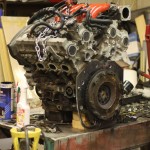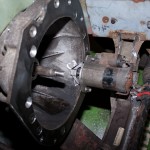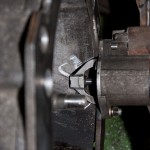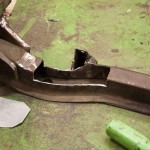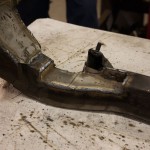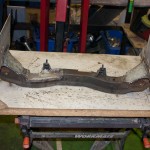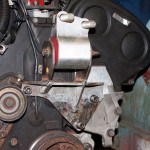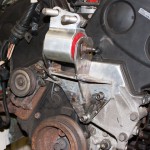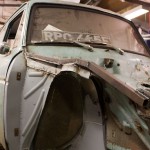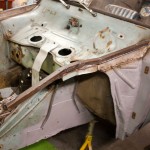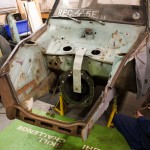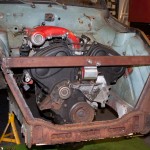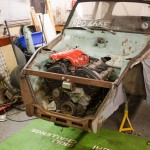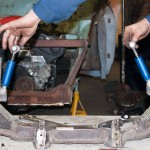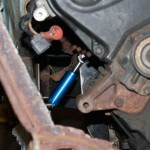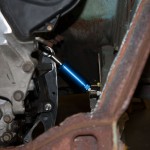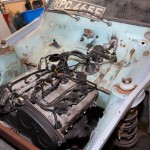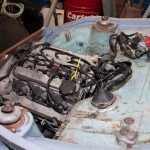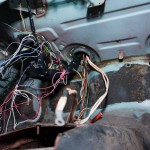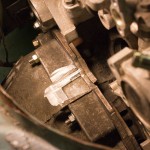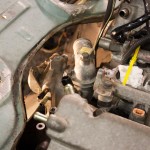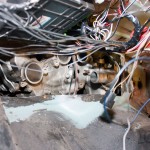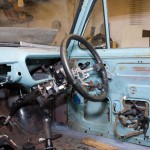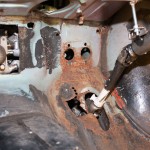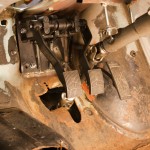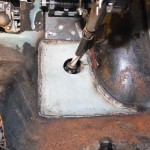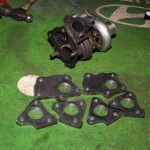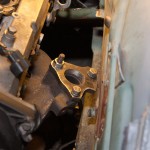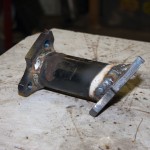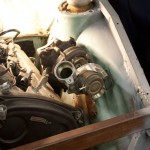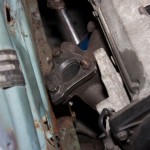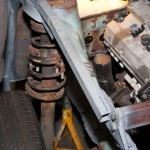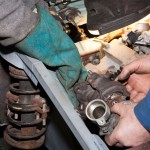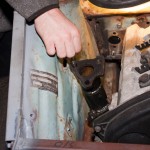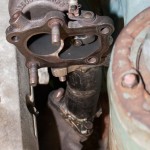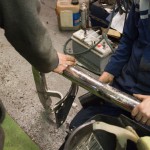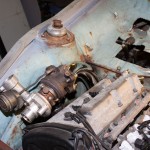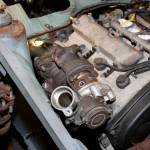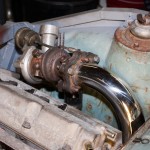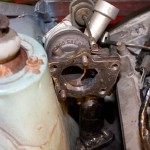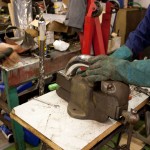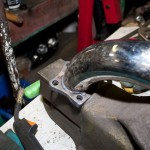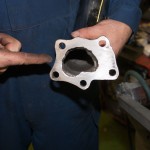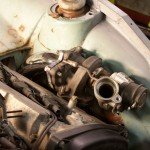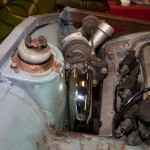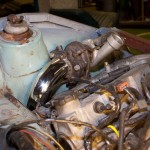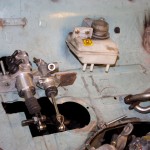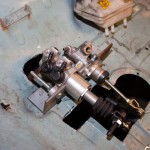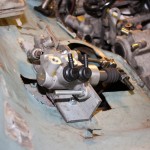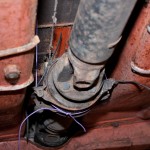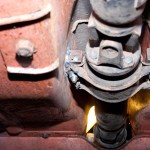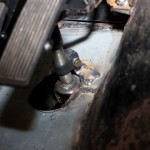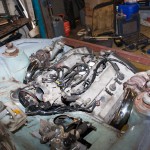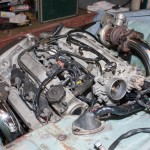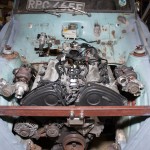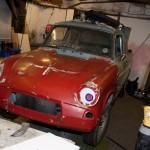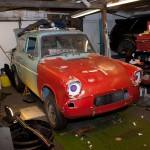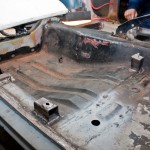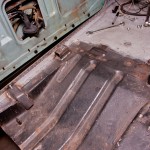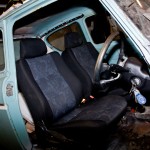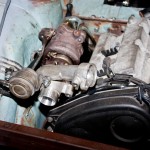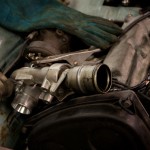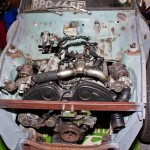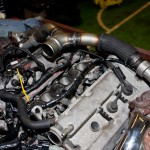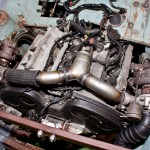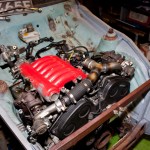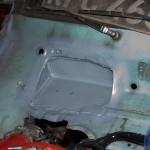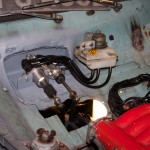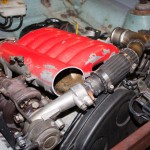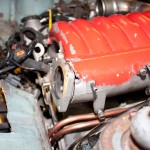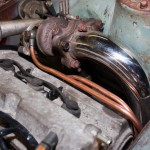I blame my dad entirely for my passion for cars. He's a mechanic by trade, but he also enjoys tinkering with cars in his free time.
So, I grew up surrounded by cars, and from an early age I wanted to spend all of my time with him, watching what he was doing, learning, and just generally getting under his feet and in his way. Fast forward to today, and I'm much the same, albeit now I've got a bit more knowledge, and am now a bit too tall to literally get "under his feet" (but I sometimes still do in the figurative way).
In the mid 90's, my dad got his 2nd Ford Anglia - a 1966 Deluxe, which was in quite a sad state, and needed a bit of repair work. Unfortunately time was tight, so it was completed, with a 1500GT engine (later a 1300 crossflow) and it went on the road. I loved going out in the car, it turned heads everywhere. A few years later, he picked up another, in worse condition! This one took longer to restore, but having done something with "period" mods, this one went extreme - he took the largest shoehorn he could find, and squeezed in the full running gear from a Subaru estate car - 1800cc flat four engine and full 4WD running gear.
In 2003 I managed to get hold of a 1967 Ford Anglia Deluxe, which had failed it's MOT on a few items and the current owner couldn't afford the repairs. I started off by getting myself a Mk2 Escort with a 1600 crossflow, with plans of putting that in. I made a start, but didn't get much further than stripping the car to mostly a bare shell with the Escort front suspension fitted, before other events took over and it got sidetracked.
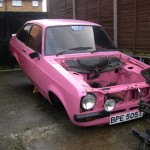
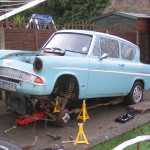
I then changed my daily driver to a Honda Prelude 2.2 VTEC, and decided that my "fun" weekend car shouldn't be slower than my daily driver, so got hold of a Nissan 200SX S13, with a 1800 turbo engine.
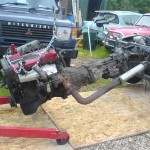
I stripped this down, but before I could make a start, I ended up damaging my Prelude, so spent a few months rebuilding that! The Anglia took a back seat again. Unfortunately, it continued to take a back seat until October 2010, when I started again on it.
The years sat outside at my dad's place had taken their toll on the car, which had developed much more rust, and it required quite a bit more work than it would have done 6 years earlier...
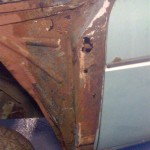
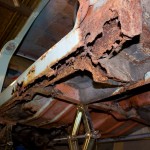
So we removed the rust, and using replacement body parts from the Owner's Club, repaired these areas and put strength back into the car.
Removing rust...
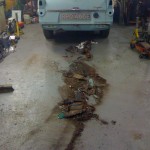
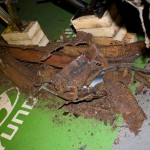
Fitting new bits...
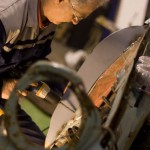
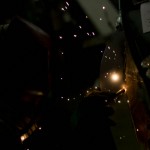
Nice new, strong metal...
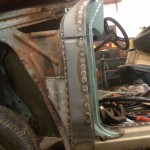
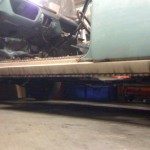
Once the strength was put into the chassis, it was time to start thinking about fitting the running gear.
However, I'd since (again) changed my daily driver to a Mitsubishi Legnum VR-4, and the 1.8 turbo engine again would have been less powerful than my daily driver! So... I've changed the choice of engine (again)!
So, introducing the Mitsubishi 6A13TT engine, as is in my Legnum VR-4:
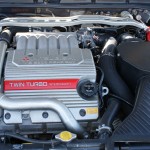
2500cc, V6, 24 valve, quad cam, twin turbo, 280bhp.
With an engine from an old Galant (the saloon version of my Legnum estate), I decided to see whether it would fit in the engine bay of the Anglia.
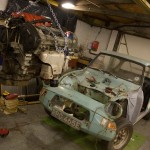
Lifting it towards the unsuspecting car
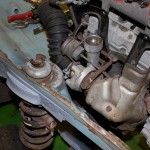
With the turbos still attached... not quite, how about without the turbos?
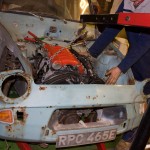
Much better!!
The 6A13 engine was never used in a Rear Wheel Drive vehicle by Mitsubishi, therefore, there are no gearboxes available “off the shelf” that will allow it to be used longitudinally.
The 6A13 is, however, compatible with gearboxes that also bolt up to the Lancer Evolution IV onwards 4G63T – but, the same problem comes – it comes in no vehicles where it’s used in a RWD configuration...
So… to the drawing board we go to find a gearbox.
Well, from my previous running gear selection, I just so happen to have a FS5W71C gearbox from the Nissan 200SX sitting around… it’s fairly compact, and the bellhousing looks a similar size to the bolt pattern for the 6A13 engine.
We had to design and have made some adapter plates to be able to attach the two together, so we began to make some templates.
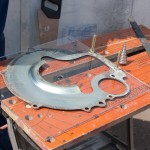
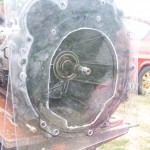
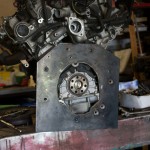
I picked up an FTO flywheel, which is the same 225mm as the Nissan gearbox (the engine came from an automatic), but with the 8mm adapter plate we had made by a local engineering firm, the back edge of the flywheel was a bit too close for comfort, so we had made up a 5mm spacer to bring the flywheel away from the block.
In a RWD box, the input shaft is supported in the end of the crank, but in a FWD or transverse gearbox (as in the VR-4) has the input shaft supported both ends within the gearbox itself, so there are no spigot bushes, and therefore no way to mount one into the VR-4 engine. So, again to our local engineering firm, who turned us up a spigot adapter to fit the end of the crank, and to fit the brass spigot bush from the 200SX.
With these adapter plates made up, and a combination of Mitsubishi FTO flywheel and clutch and the Nissan clutch, and a home-brew release bearing using FTO/200SX bits, we have managed to mate up the Mitsubishi 6A13TT engine to the Nissan 200SX FS5W71C gearbox!
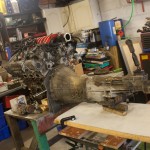
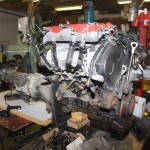
We then began to fit the gearbox into the car, making up a custom gearbox cross-member, and minor modifications to move the location of the gear lever.
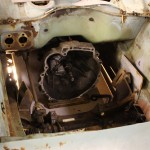
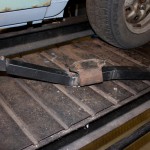
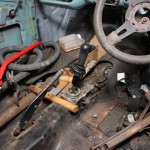
We were then able to drop the engine in place, mate it up to the gearbox again, and even fit the Nissan propshaft - which was the perfect length to mate up to the standard Anglia rear axle!!
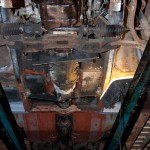
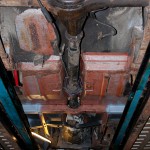
So, here we are, with engine/gearbox/propshaft bolted together - next on the list is to modify the front crossmember to remove the existing engine mounts, as we'll be making up new custom engine mounts.
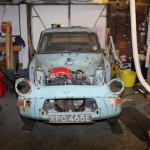
So, I grew up surrounded by cars, and from an early age I wanted to spend all of my time with him, watching what he was doing, learning, and just generally getting under his feet and in his way. Fast forward to today, and I'm much the same, albeit now I've got a bit more knowledge, and am now a bit too tall to literally get "under his feet" (but I sometimes still do in the figurative way).
In the mid 90's, my dad got his 2nd Ford Anglia - a 1966 Deluxe, which was in quite a sad state, and needed a bit of repair work. Unfortunately time was tight, so it was completed, with a 1500GT engine (later a 1300 crossflow) and it went on the road. I loved going out in the car, it turned heads everywhere. A few years later, he picked up another, in worse condition! This one took longer to restore, but having done something with "period" mods, this one went extreme - he took the largest shoehorn he could find, and squeezed in the full running gear from a Subaru estate car - 1800cc flat four engine and full 4WD running gear.
In 2003 I managed to get hold of a 1967 Ford Anglia Deluxe, which had failed it's MOT on a few items and the current owner couldn't afford the repairs. I started off by getting myself a Mk2 Escort with a 1600 crossflow, with plans of putting that in. I made a start, but didn't get much further than stripping the car to mostly a bare shell with the Escort front suspension fitted, before other events took over and it got sidetracked.


I then changed my daily driver to a Honda Prelude 2.2 VTEC, and decided that my "fun" weekend car shouldn't be slower than my daily driver, so got hold of a Nissan 200SX S13, with a 1800 turbo engine.

I stripped this down, but before I could make a start, I ended up damaging my Prelude, so spent a few months rebuilding that! The Anglia took a back seat again. Unfortunately, it continued to take a back seat until October 2010, when I started again on it.
The years sat outside at my dad's place had taken their toll on the car, which had developed much more rust, and it required quite a bit more work than it would have done 6 years earlier...


So we removed the rust, and using replacement body parts from the Owner's Club, repaired these areas and put strength back into the car.
Removing rust...


Fitting new bits...


Nice new, strong metal...


Once the strength was put into the chassis, it was time to start thinking about fitting the running gear.
However, I'd since (again) changed my daily driver to a Mitsubishi Legnum VR-4, and the 1.8 turbo engine again would have been less powerful than my daily driver! So... I've changed the choice of engine (again)!
So, introducing the Mitsubishi 6A13TT engine, as is in my Legnum VR-4:

2500cc, V6, 24 valve, quad cam, twin turbo, 280bhp.
With an engine from an old Galant (the saloon version of my Legnum estate), I decided to see whether it would fit in the engine bay of the Anglia.

Lifting it towards the unsuspecting car

With the turbos still attached... not quite, how about without the turbos?

Much better!!
The 6A13 engine was never used in a Rear Wheel Drive vehicle by Mitsubishi, therefore, there are no gearboxes available “off the shelf” that will allow it to be used longitudinally.
The 6A13 is, however, compatible with gearboxes that also bolt up to the Lancer Evolution IV onwards 4G63T – but, the same problem comes – it comes in no vehicles where it’s used in a RWD configuration...
So… to the drawing board we go to find a gearbox.
Well, from my previous running gear selection, I just so happen to have a FS5W71C gearbox from the Nissan 200SX sitting around… it’s fairly compact, and the bellhousing looks a similar size to the bolt pattern for the 6A13 engine.
We had to design and have made some adapter plates to be able to attach the two together, so we began to make some templates.



I picked up an FTO flywheel, which is the same 225mm as the Nissan gearbox (the engine came from an automatic), but with the 8mm adapter plate we had made by a local engineering firm, the back edge of the flywheel was a bit too close for comfort, so we had made up a 5mm spacer to bring the flywheel away from the block.
In a RWD box, the input shaft is supported in the end of the crank, but in a FWD or transverse gearbox (as in the VR-4) has the input shaft supported both ends within the gearbox itself, so there are no spigot bushes, and therefore no way to mount one into the VR-4 engine. So, again to our local engineering firm, who turned us up a spigot adapter to fit the end of the crank, and to fit the brass spigot bush from the 200SX.
With these adapter plates made up, and a combination of Mitsubishi FTO flywheel and clutch and the Nissan clutch, and a home-brew release bearing using FTO/200SX bits, we have managed to mate up the Mitsubishi 6A13TT engine to the Nissan 200SX FS5W71C gearbox!


We then began to fit the gearbox into the car, making up a custom gearbox cross-member, and minor modifications to move the location of the gear lever.



We were then able to drop the engine in place, mate it up to the gearbox again, and even fit the Nissan propshaft - which was the perfect length to mate up to the standard Anglia rear axle!!


So, here we are, with engine/gearbox/propshaft bolted together - next on the list is to modify the front crossmember to remove the existing engine mounts, as we'll be making up new custom engine mounts.

Last edited:


